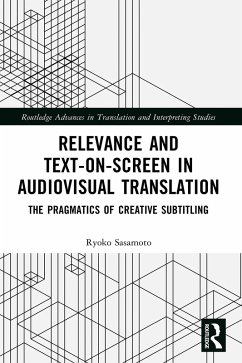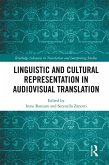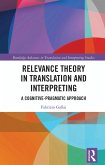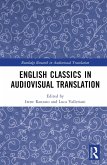Ryoko Sasamoto
Relevance and Text-on-Screen in Audiovisual Translation (eBook, PDF)
The Pragmatics of Creative Subtitling
42,95 €
42,95 €
inkl. MwSt.
Sofort per Download lieferbar

21 °P sammeln
42,95 €
Als Download kaufen

42,95 €
inkl. MwSt.
Sofort per Download lieferbar

21 °P sammeln
Jetzt verschenken
Alle Infos zum eBook verschenken
42,95 €
inkl. MwSt.
Sofort per Download lieferbar
Alle Infos zum eBook verschenken

21 °P sammeln
Ryoko Sasamoto
Relevance and Text-on-Screen in Audiovisual Translation (eBook, PDF)
The Pragmatics of Creative Subtitling
- Format: PDF
- Merkliste
- Auf die Merkliste
- Bewerten Bewerten
- Teilen
- Produkt teilen
- Produkterinnerung
- Produkterinnerung

Bitte loggen Sie sich zunächst in Ihr Kundenkonto ein oder registrieren Sie sich bei
bücher.de, um das eBook-Abo tolino select nutzen zu können.
Hier können Sie sich einloggen
Hier können Sie sich einloggen
Sie sind bereits eingeloggt. Klicken Sie auf 2. tolino select Abo, um fortzufahren.

Bitte loggen Sie sich zunächst in Ihr Kundenkonto ein oder registrieren Sie sich bei bücher.de, um das eBook-Abo tolino select nutzen zu können.
This book examines audiovisual translation practices that fall outside conventional AVT norms, drawing on work from Relevance Theory to highlight alternative perspectives and make the case for a multidisciplinary approach to AVT.
- Geräte: PC
- mit Kopierschutz
- eBook Hilfe
Andere Kunden interessierten sich auch für
![Linguistic and Cultural Representation in Audiovisual Translation (eBook, PDF) Linguistic and Cultural Representation in Audiovisual Translation (eBook, PDF)]() Linguistic and Cultural Representation in Audiovisual Translation (eBook, PDF)44,95 €
Linguistic and Cultural Representation in Audiovisual Translation (eBook, PDF)44,95 €![Relevance Theory in Translation and Interpreting (eBook, PDF) Relevance Theory in Translation and Interpreting (eBook, PDF)]() Fabrizio GallaiRelevance Theory in Translation and Interpreting (eBook, PDF)42,95 €
Fabrizio GallaiRelevance Theory in Translation and Interpreting (eBook, PDF)42,95 €![The Palgrave Handbook of Multilingualism and Language Varieties on Screen (eBook, PDF) The Palgrave Handbook of Multilingualism and Language Varieties on Screen (eBook, PDF)]() The Palgrave Handbook of Multilingualism and Language Varieties on Screen (eBook, PDF)226,95 €
The Palgrave Handbook of Multilingualism and Language Varieties on Screen (eBook, PDF)226,95 €![English Classics in Audiovisual Translation (eBook, PDF) English Classics in Audiovisual Translation (eBook, PDF)]() English Classics in Audiovisual Translation (eBook, PDF)42,95 €
English Classics in Audiovisual Translation (eBook, PDF)42,95 €![Audiovisual Translation in India (eBook, PDF) Audiovisual Translation in India (eBook, PDF)]() Priyanka RachabattuniAudiovisual Translation in India (eBook, PDF)37,95 €
Priyanka RachabattuniAudiovisual Translation in India (eBook, PDF)37,95 €![Introducing Audiovisual Translation (eBook, PDF) Introducing Audiovisual Translation (eBook, PDF)]() Agnieszka SzarkowskaIntroducing Audiovisual Translation (eBook, PDF)40,95 €
Agnieszka SzarkowskaIntroducing Audiovisual Translation (eBook, PDF)40,95 €![Relevance and Text-on-Screen in Audiovisual Translation (eBook, ePUB) Relevance and Text-on-Screen in Audiovisual Translation (eBook, ePUB)]() Ryoko SasamotoRelevance and Text-on-Screen in Audiovisual Translation (eBook, ePUB)42,95 €
Ryoko SasamotoRelevance and Text-on-Screen in Audiovisual Translation (eBook, ePUB)42,95 €-
-
-
This book examines audiovisual translation practices that fall outside conventional AVT norms, drawing on work from Relevance Theory to highlight alternative perspectives and make the case for a multidisciplinary approach to AVT.
Dieser Download kann aus rechtlichen Gründen nur mit Rechnungsadresse in A, B, BG, CY, CZ, D, DK, EW, E, FIN, F, GR, HR, H, IRL, I, LT, L, LR, M, NL, PL, P, R, S, SLO, SK ausgeliefert werden.
Produktdetails
- Produktdetails
- Verlag: Taylor & Francis eBooks
- Seitenzahl: 196
- Erscheinungstermin: 29. Mai 2024
- Englisch
- ISBN-13: 9781003862826
- Artikelnr.: 70403073
- Verlag: Taylor & Francis eBooks
- Seitenzahl: 196
- Erscheinungstermin: 29. Mai 2024
- Englisch
- ISBN-13: 9781003862826
- Artikelnr.: 70403073
- Herstellerkennzeichnung Die Herstellerinformationen sind derzeit nicht verfügbar.
Ryoko Sasamoto is Associate Professor in the School of Applied Language and Intercultural Studies (SALIS) and a member of the Centre for Translation and Textual Studies (CTTS) at Dublin City University, Ireland.
Contents
List of Figures
List of Tables
Acknowledgement
1. Text-on-Screen
1.1 Introduction
1.1.1 Examples of Text-on-Screen
1.1.2 Emergence and Historical Development
1.1.3 Typologies of Text-on-Screen
1.1.4 Terminology
1.2 Prevalence of Text-on-Screen
1.2.1 Methodology
1.2.2 Findings: Prevalence of Text-on-Screen
1.3 Towards a Pragmatics of Text-on-Screen
2. Cognitive-Pragmatic Approaches in Translation Studies
2.1 Introduction
2.2 Relevance Theory
2.3 Relevance Theory and Translation
2.4 Relevance Theory in Translation Studies
2.5 Relevance Theory and its Application to AVT Research
2.6 Relevance and Text-on-Screen: Key Notions
2.6.1 Epistemic Vigilance and Epistemic Trust
2.6.2 Context and Audience
2.6.3 Mutual Manifestness: Cognitive and Affective Mutuality
3. Creative and Innovative Subtitling: How Viewers Process Creative Pop-up
Captions on TV
3.1 Telop: Basics
3.1.1 Text-on-Screen in Entertainment Shows and Drama
3.1.2 Reaction to Impact Captions: Previous Studies
3.2 Relevance-Theoretic Analysis
3.2.1 The Role of Telop: Viewer Manipulation
3.2.2 Telop and Affective Response
3.2.3 Telop and Cognitive Mutuality
3.2.4 Telop and the Two-Dimensional Space of Intended Import
3.2.5 Conclusion
4. Text-on-Screen and Social Impact: Vigilance and Trust
4.1 Misuse of Text-on-Screen
4.2 Epistemic Vigilance and Epistemic Trust
4.3 Epistemic Vigilance and Problematic Text-on-Screen Use
4.3.1 Misuse, Vigilance, and Trust
4.3.2 Epistemic Vigilance, Attributed Thoughts, and Mockery
5. An Empirical Approach to AVT: Overview of Eye-Tracking in AVT Research
5.1 Eye-Tracking as a Research Method
5.1.1 Introduction
5.1.2 Eye-Tracking
5.2 Development of Eye-Tracking Research in AVT
5.2.1 Early Research
5.2.2 Legibility, Readability, and Strategies
5.2.3 Individual Factors and Subtitle Processing
5.2.4 Subtitles in Academic Contexts
5.3 Non-Standard Subtitling and Creative Text-on-Screen
5.3.1 Eye-Tracking Research into Innovative Titling
5.3.2 Impact Captions and Eye-Tracking
6. An Empirical Approach to AVT: A Case Study - Eye-Tracking, Ageing, and
Viewing Behaviour
6.1 Viewer Needs and AVT Research
6.2 Older Viewers, TV Viewing, and Cognitive Processing
6.3 Methodology
6.3.1 Design
6.3.2 Location and Participants
6.3.3 Types of Telop and Areas of Interest
6.3.4 Questionnaires
6.4 Findings
6.4.1 Study 1
6.4.2 Study 2
6.5 Discussion
6.5.1 Overall Attention to the Programme
6.5.2 Distribution of Attention
6.5.3 The Types of Telop and Impact on Reception
6.5.4 Viewing Habits and Recall
6.6 Conclusion
7. Participatory Culture, Social Media, and Text-on-Screen: Sharing
Emotions via the Use of Creative Titling
7.1 Introduction
7.2 Shared Viewing
7.2.1 Overview
7.2.2 Shared Viewing Platforms: Danmaku/Danmu (Bullet Titling) and Live
Commentary
7.3 Relevance of Live Comments: A Pragmatic Analysis 190
7.3.1 Sharing Information
7.3.2 Sharing Reactions 197
7.4. Conclusion
8. Conclusion and Future Directions
Index
List of Figures
List of Tables
Acknowledgement
1. Text-on-Screen
1.1 Introduction
1.1.1 Examples of Text-on-Screen
1.1.2 Emergence and Historical Development
1.1.3 Typologies of Text-on-Screen
1.1.4 Terminology
1.2 Prevalence of Text-on-Screen
1.2.1 Methodology
1.2.2 Findings: Prevalence of Text-on-Screen
1.3 Towards a Pragmatics of Text-on-Screen
2. Cognitive-Pragmatic Approaches in Translation Studies
2.1 Introduction
2.2 Relevance Theory
2.3 Relevance Theory and Translation
2.4 Relevance Theory in Translation Studies
2.5 Relevance Theory and its Application to AVT Research
2.6 Relevance and Text-on-Screen: Key Notions
2.6.1 Epistemic Vigilance and Epistemic Trust
2.6.2 Context and Audience
2.6.3 Mutual Manifestness: Cognitive and Affective Mutuality
3. Creative and Innovative Subtitling: How Viewers Process Creative Pop-up
Captions on TV
3.1 Telop: Basics
3.1.1 Text-on-Screen in Entertainment Shows and Drama
3.1.2 Reaction to Impact Captions: Previous Studies
3.2 Relevance-Theoretic Analysis
3.2.1 The Role of Telop: Viewer Manipulation
3.2.2 Telop and Affective Response
3.2.3 Telop and Cognitive Mutuality
3.2.4 Telop and the Two-Dimensional Space of Intended Import
3.2.5 Conclusion
4. Text-on-Screen and Social Impact: Vigilance and Trust
4.1 Misuse of Text-on-Screen
4.2 Epistemic Vigilance and Epistemic Trust
4.3 Epistemic Vigilance and Problematic Text-on-Screen Use
4.3.1 Misuse, Vigilance, and Trust
4.3.2 Epistemic Vigilance, Attributed Thoughts, and Mockery
5. An Empirical Approach to AVT: Overview of Eye-Tracking in AVT Research
5.1 Eye-Tracking as a Research Method
5.1.1 Introduction
5.1.2 Eye-Tracking
5.2 Development of Eye-Tracking Research in AVT
5.2.1 Early Research
5.2.2 Legibility, Readability, and Strategies
5.2.3 Individual Factors and Subtitle Processing
5.2.4 Subtitles in Academic Contexts
5.3 Non-Standard Subtitling and Creative Text-on-Screen
5.3.1 Eye-Tracking Research into Innovative Titling
5.3.2 Impact Captions and Eye-Tracking
6. An Empirical Approach to AVT: A Case Study - Eye-Tracking, Ageing, and
Viewing Behaviour
6.1 Viewer Needs and AVT Research
6.2 Older Viewers, TV Viewing, and Cognitive Processing
6.3 Methodology
6.3.1 Design
6.3.2 Location and Participants
6.3.3 Types of Telop and Areas of Interest
6.3.4 Questionnaires
6.4 Findings
6.4.1 Study 1
6.4.2 Study 2
6.5 Discussion
6.5.1 Overall Attention to the Programme
6.5.2 Distribution of Attention
6.5.3 The Types of Telop and Impact on Reception
6.5.4 Viewing Habits and Recall
6.6 Conclusion
7. Participatory Culture, Social Media, and Text-on-Screen: Sharing
Emotions via the Use of Creative Titling
7.1 Introduction
7.2 Shared Viewing
7.2.1 Overview
7.2.2 Shared Viewing Platforms: Danmaku/Danmu (Bullet Titling) and Live
Commentary
7.3 Relevance of Live Comments: A Pragmatic Analysis 190
7.3.1 Sharing Information
7.3.2 Sharing Reactions 197
7.4. Conclusion
8. Conclusion and Future Directions
Index
Contents
List of Figures
List of Tables
Acknowledgement
1. Text-on-Screen
1.1 Introduction
1.1.1 Examples of Text-on-Screen
1.1.2 Emergence and Historical Development
1.1.3 Typologies of Text-on-Screen
1.1.4 Terminology
1.2 Prevalence of Text-on-Screen
1.2.1 Methodology
1.2.2 Findings: Prevalence of Text-on-Screen
1.3 Towards a Pragmatics of Text-on-Screen
2. Cognitive-Pragmatic Approaches in Translation Studies
2.1 Introduction
2.2 Relevance Theory
2.3 Relevance Theory and Translation
2.4 Relevance Theory in Translation Studies
2.5 Relevance Theory and its Application to AVT Research
2.6 Relevance and Text-on-Screen: Key Notions
2.6.1 Epistemic Vigilance and Epistemic Trust
2.6.2 Context and Audience
2.6.3 Mutual Manifestness: Cognitive and Affective Mutuality
3. Creative and Innovative Subtitling: How Viewers Process Creative Pop-up
Captions on TV
3.1 Telop: Basics
3.1.1 Text-on-Screen in Entertainment Shows and Drama
3.1.2 Reaction to Impact Captions: Previous Studies
3.2 Relevance-Theoretic Analysis
3.2.1 The Role of Telop: Viewer Manipulation
3.2.2 Telop and Affective Response
3.2.3 Telop and Cognitive Mutuality
3.2.4 Telop and the Two-Dimensional Space of Intended Import
3.2.5 Conclusion
4. Text-on-Screen and Social Impact: Vigilance and Trust
4.1 Misuse of Text-on-Screen
4.2 Epistemic Vigilance and Epistemic Trust
4.3 Epistemic Vigilance and Problematic Text-on-Screen Use
4.3.1 Misuse, Vigilance, and Trust
4.3.2 Epistemic Vigilance, Attributed Thoughts, and Mockery
5. An Empirical Approach to AVT: Overview of Eye-Tracking in AVT Research
5.1 Eye-Tracking as a Research Method
5.1.1 Introduction
5.1.2 Eye-Tracking
5.2 Development of Eye-Tracking Research in AVT
5.2.1 Early Research
5.2.2 Legibility, Readability, and Strategies
5.2.3 Individual Factors and Subtitle Processing
5.2.4 Subtitles in Academic Contexts
5.3 Non-Standard Subtitling and Creative Text-on-Screen
5.3.1 Eye-Tracking Research into Innovative Titling
5.3.2 Impact Captions and Eye-Tracking
6. An Empirical Approach to AVT: A Case Study - Eye-Tracking, Ageing, and
Viewing Behaviour
6.1 Viewer Needs and AVT Research
6.2 Older Viewers, TV Viewing, and Cognitive Processing
6.3 Methodology
6.3.1 Design
6.3.2 Location and Participants
6.3.3 Types of Telop and Areas of Interest
6.3.4 Questionnaires
6.4 Findings
6.4.1 Study 1
6.4.2 Study 2
6.5 Discussion
6.5.1 Overall Attention to the Programme
6.5.2 Distribution of Attention
6.5.3 The Types of Telop and Impact on Reception
6.5.4 Viewing Habits and Recall
6.6 Conclusion
7. Participatory Culture, Social Media, and Text-on-Screen: Sharing
Emotions via the Use of Creative Titling
7.1 Introduction
7.2 Shared Viewing
7.2.1 Overview
7.2.2 Shared Viewing Platforms: Danmaku/Danmu (Bullet Titling) and Live
Commentary
7.3 Relevance of Live Comments: A Pragmatic Analysis 190
7.3.1 Sharing Information
7.3.2 Sharing Reactions 197
7.4. Conclusion
8. Conclusion and Future Directions
Index
List of Figures
List of Tables
Acknowledgement
1. Text-on-Screen
1.1 Introduction
1.1.1 Examples of Text-on-Screen
1.1.2 Emergence and Historical Development
1.1.3 Typologies of Text-on-Screen
1.1.4 Terminology
1.2 Prevalence of Text-on-Screen
1.2.1 Methodology
1.2.2 Findings: Prevalence of Text-on-Screen
1.3 Towards a Pragmatics of Text-on-Screen
2. Cognitive-Pragmatic Approaches in Translation Studies
2.1 Introduction
2.2 Relevance Theory
2.3 Relevance Theory and Translation
2.4 Relevance Theory in Translation Studies
2.5 Relevance Theory and its Application to AVT Research
2.6 Relevance and Text-on-Screen: Key Notions
2.6.1 Epistemic Vigilance and Epistemic Trust
2.6.2 Context and Audience
2.6.3 Mutual Manifestness: Cognitive and Affective Mutuality
3. Creative and Innovative Subtitling: How Viewers Process Creative Pop-up
Captions on TV
3.1 Telop: Basics
3.1.1 Text-on-Screen in Entertainment Shows and Drama
3.1.2 Reaction to Impact Captions: Previous Studies
3.2 Relevance-Theoretic Analysis
3.2.1 The Role of Telop: Viewer Manipulation
3.2.2 Telop and Affective Response
3.2.3 Telop and Cognitive Mutuality
3.2.4 Telop and the Two-Dimensional Space of Intended Import
3.2.5 Conclusion
4. Text-on-Screen and Social Impact: Vigilance and Trust
4.1 Misuse of Text-on-Screen
4.2 Epistemic Vigilance and Epistemic Trust
4.3 Epistemic Vigilance and Problematic Text-on-Screen Use
4.3.1 Misuse, Vigilance, and Trust
4.3.2 Epistemic Vigilance, Attributed Thoughts, and Mockery
5. An Empirical Approach to AVT: Overview of Eye-Tracking in AVT Research
5.1 Eye-Tracking as a Research Method
5.1.1 Introduction
5.1.2 Eye-Tracking
5.2 Development of Eye-Tracking Research in AVT
5.2.1 Early Research
5.2.2 Legibility, Readability, and Strategies
5.2.3 Individual Factors and Subtitle Processing
5.2.4 Subtitles in Academic Contexts
5.3 Non-Standard Subtitling and Creative Text-on-Screen
5.3.1 Eye-Tracking Research into Innovative Titling
5.3.2 Impact Captions and Eye-Tracking
6. An Empirical Approach to AVT: A Case Study - Eye-Tracking, Ageing, and
Viewing Behaviour
6.1 Viewer Needs and AVT Research
6.2 Older Viewers, TV Viewing, and Cognitive Processing
6.3 Methodology
6.3.1 Design
6.3.2 Location and Participants
6.3.3 Types of Telop and Areas of Interest
6.3.4 Questionnaires
6.4 Findings
6.4.1 Study 1
6.4.2 Study 2
6.5 Discussion
6.5.1 Overall Attention to the Programme
6.5.2 Distribution of Attention
6.5.3 The Types of Telop and Impact on Reception
6.5.4 Viewing Habits and Recall
6.6 Conclusion
7. Participatory Culture, Social Media, and Text-on-Screen: Sharing
Emotions via the Use of Creative Titling
7.1 Introduction
7.2 Shared Viewing
7.2.1 Overview
7.2.2 Shared Viewing Platforms: Danmaku/Danmu (Bullet Titling) and Live
Commentary
7.3 Relevance of Live Comments: A Pragmatic Analysis 190
7.3.1 Sharing Information
7.3.2 Sharing Reactions 197
7.4. Conclusion
8. Conclusion and Future Directions
Index







